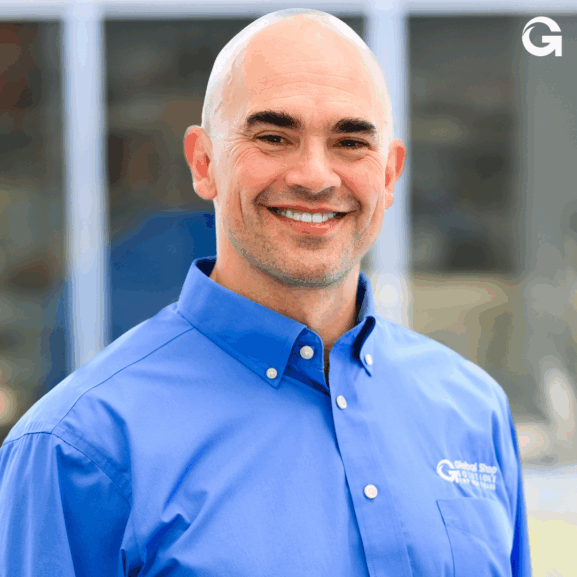10 Essentials for Minimizing the Engineer-to-Order (ETO) Lifecycle

A White Paper
By Jarrett R. Smith
Operations Consultant
Global Shop Solutions
This white paper provides 10 essential ways manufacturers can reduce their production times and boost their profitability by addressing the unique challenges of ETO manufacturing.
The Challenges
• Getting Your Organization Aligned: How (and where) do you collect and share the trove of customer-supplied design documents including: layouts, design specs, drawings, spreadsheets and more?
• Capturing Costs and Analytics: How do you accurately track multiple cost drivers from engineering, materials, production, labor and services and prevent overruns before they spin out of control?
• Making Real-Time Adjustments: How do you adjust for complex design changes and unforeseen disruptions to make optimal production decisions on-the-fly to ensure on-time delivery of the finished product?
• Communicating with Customers: How do you arm your employees with the information needed to make the customer feel properly engaged throughout the entire ETO lifecycle?
The Solutions
1. Reduce Response Times to Customer Requests for Quote (RFQs)
When your organization has been selected as a candidate to produce an ETO solution, the data and fact-finding mission is the critical first step. This task includes aggregating a variety of resources, documents, and files including CAD drawings, solid models, phone calls, emails, spreadsheets, or even a paper napkin sketches. Everything needs to be documented and consolidated into one easily accessible location so your design and production teams can quickly and effortlessly create a qualified, competitive quote.
A Document Control system with a built-in RFQ workflow can provide an elegant solution for storing and routing your digital files for faster approval to meet tight RFQ deadlines. And once the bid is won, you’re now ready to attach digital files to work orders, sales order, inventory lists, purchase orders and more. A fully functional document control system can turn your organization into a lean, paperless manufacturing environment.
2. Quote with Precision and Confidence
For ETO manufacturers, the processes used to calculate price quotes and delivery dates come in an array of techniques, from simple spreadsheets to complex, algorithm-based calculations. Producing a quoted price that is not reflective of your true cost is a risk that can be mitigated by accessing the historical data already captured in your ERP system.
The most successful and efficient manufacturers take all the guesswork out of the quoting process by using an automated system for pricing and quoting anything they are manufacturing.
• Existing designs and reference bills of material (BOMs) readily pulled from your system should be the foundational pieces of information needed for creating an ETO quote.
• Real-time raw material costs found in the inventory master should be factored into the quote.
• Your suppliers can further validate costs. Supplier communications through an integrated Customer Relationship Management (CRM) system helps keep the multitude of emails in one place and tied to your project.
• Pushing these inventory costs into to a router/estimate will combine the latest costs into a new quote without waiting for a new price sheet to be updated.
• And finally, your Estimators should also access historical job performance on past products and make adjustments to avoid potential cost overruns.
Now that your quote is complete and approved, you can send it with high confidence knowing your estimates are precise. History doesn’t always repeat but it often rhymes, which favors ETO manufacturers who can harvest past data to inform their future quotes.
3. Be Ready for Kickoff Before the Order is Won
Sales has converted the quote and acknowledged the successful “winning” of the order. When the purchase order (PO) has finally arrived, the stage is set for a series of kickoff activities for your company. Are you ready?
When that PO hits your system, all known requirements should already be accessible and transparent in your system. The ERP system’s sales order acknowledgment should automatically put into motion a series of baseline activities in preparation for the formal kickoff including creation of the new product design part numbers, description, terms and conditions, as well as pricing and due dates. This is also an opportunity to share this information with your customer and internal stakeholders to create clarity and alignment on the build expectations.
4. Create a Home Base for Project Kickoff
Henry Ford is credited with proclaiming that “If everyone is moving forward together, then success takes care of itself.” The Project Kickoff is the point where everyone starts moving forward together. For the ETO manufacturer, the Project Kickoff converts customer design specifications into a production prescription.
An ERP system should be a home base for a Project Kickoff. The ERP should generate a new project number that will serve as the umbrella for collecting and disseminating the order lifecycle components. In a Project Kickoff, a cross-functional team reviews all the aggregated data and translates this into project risks, opportunities, timelines, and priorities. Parallel work streams should be developed, engineering and design work orders should be started, and lead times for purchased items should be examined.
A project consists of a work breakdown structure, translating production steps into phases and groups that collect costs/revenue and provide budgetary estimates for timelines and schedules.
Defining the boundaries during project kickoff combines the resources to successfully launch a new ETO project into a formal engineering/design review.
5. Measure Twice and Cut Once: Convert Concepts into a Design for Manufacturability (DFM)
Engineers and designers provide the technical blueprint for a successful ETO campaign. Finalizing the BOM and production router precedes production scheduling and material resource planning. Is it simply a stamp of approval to begin production? Of course not!
During the engineering and design phase, you can expect to produce production support elements including but not limited to:
• Electrical and mechanical schematic drawings
• 3D solid model and 2D dimensional CAD drawings
• Raw material, component part, consumable part numbers
• Labor and outside service workflows
• Special design notes and callouts
Your ERP system should translate engineering design into a DFM – a plan for making a better product at a lower cost. A robust design review allows the shop floor to create an achievable production plan to build a high-quality finished product.
ETO manufacturers are often faced with concurrent engineering demands that require new drawings and specifications to be developed in parallel with production. A modular design and release protocol for assembled elements can sequence the engineering design into a successful production solution.
At the conclusion of the engineering and design review, a digital sign-off should be available in your ERP system. Production and supply chain planners can now take the stamp of approval and begin production on fulfilling order requirements for project release.
6. Automate Your Raw Materials Management and Inventory
The flood gate of new material requirements leads to a scramble for vendor quotes, Pos, and forklifts to offload a daily stream of raw goods. Visibility of material order fulfillment to coordinate and automate processes is essential.
The most successful manufacturers rely on automated purchasing, so they know when to buy parts and in what quantity. An ERP system should provide real-time statuses of purchased raw materials and inventory management. Delays and scheduling changes should be regularly reviewed and updated for production. Inventory and warehouse teams should allocate raw materials to a project in a timely manner. As material costs are added to the project, tracking of project completion can be managed and reviewed.
This orchestra of material management is dynamic. Planners and buyers need their ERP system to track status in a real- time dashboard format. The intersection of materials and schedules can cause a traffic jam of information, particularly when dependencies are at stake. As inventory requirements are fulfilled, production planners can queue the release of jobs into production for manufacturing to begin.
7. Create a Master Production Schedule That Can Adjust on the Fly
The production job release is the trigger that tells everyone you’re ready to produce. The production team now needs two things: a ready-to-go Master Production Schedule and a software system that empowers them to make adjustments when the inevitable change request occurs.
For some companies, kicking off production means more production meetings, coordinating people’s schedules, reviewing existing production schedules, and so on. The chances of miscommunication or missing information increase without lockstep coordination. One of the key elements for getting your team off to a smooth start is a simple data entry system that alerts everyone involved that the Master Production Schedule is now available/accessible and it’s time to get to work.
An ERP system should leverage the Master Production Schedule to layout production sequencing to create a part in the least amount of time. Everyone should know which jobs/workorders are in progress and which ones are still queued for release. Furthermore, the Master Production Schedule should be flexible enough to handle what-if scenarios. Customer demands can change, even daily, and schedules are never written in stone. Your ERP system should be able to handle these emergencies to maintain a steady level of operation and provide a way to evaluate the impact of this reschedule on tools, materials, and labor. By having such capability in place, you can maximize the efficiency of your operation in the event of sudden changes.
8. Set Up Real-Time Monitoring to Stay On-Track
Understanding the true cost of goods sold (COGS) for your ETO product can be a daunting task given all the cost components that go into that number. Furthermore, disruptions that impact material and labor costs can quickly erode profit margins with limited visibility into the true cost drivers.
Real-time cost monitoring gives you the ability to measure your job profitability during production or when production has been completed. It should also let you compare your estimated dollars/ hours vs actual dollars/hours for all labor and material costs. Real-time cost monitoring aided by touch screen Shop Floor Data Collection stations and barcoded work orders helps your team become more responsive when action is needed and prevents unwelcome surprises post production.
As your ERP system reviews actual status of jobs, managers and operators can respond to a steady stream of feedback that keeps progress on track against your KPIs. Your ERP system should plant red flags when current work in progress is deviating from planned labor and material allocations and highlight what needs to be improved.
Priorities change and reschedules are inevitable. How do you respond? With confidence, enabling skilled teams supported with data analytics to uncover the potential unknown risks that exist during ETO production.
As more value is added in the form of labor, outside/contract services, and overhead, your projects can be refreshed. A reliable accounting of the budget estimated costs and actual costs can be calculated to ensure project objectives are met and corrective actions are taken when necessary. Routines are maintained and refreshed all the way to the finish line.
Real-time cost and progress monitoring on dynamic dashboards from your ERP system gives your production team maximum visibility into profitability and lets your project managers sleep better at night.
9. Know Your Final Costs Before You Ship
A line of transportation trucks is backing up to the dock and ready for delivery to customer destinations. Load it up and ship, ship, ship! Right? Not so fast! ETO manufacturers need to be prepared to consolidate the work, prepare cost reviews, and book inventory valuations for future data analysis and profit review. You are in business to make profits. Therefore, it is important to review your production costs prior to shipping.
Forward thinking ETO manufacturers are booking COGS to inventory throughout the lifecycle and need a last-minute review and sign- off to ensure that costs were not left out. Did you receive all POs? Did you issue the materials to completion? Has labor been reconciled for the last day of activity? With an affirmative and decisive review, your ETO products can stage while the administrative cost review team signs off on the completed job.
The shipping dock readies the packaging, labels, and begins to schedule pick-up from third party logistics or in-house transportation. Your ERP system should show the readiness of all inventories prior to shipment. A robust Dashboard of all open sales orders with an accounting of on-hand quantity permits shipping to proceed with final preparations to deliver on-time and on-budget.
10. Evaluate Your Performance
Now that costs are finalized and the order has been invoiced, a diligent review of your KPIs can begin. Did we estimate accurately? Did we execute the plan with the precision required? The good news is the answer should be known before it was asked. Your ERP system reviews costs and revenues throughout the ETO lifecycle.
Analyzing specific costs or weighted average cost is recommended for your ETO project to deliver an accurate assessment of job performance. Billing cycles and invoice visibility should be readily accessible no matter the method agreed upon through the terms and conditions with your customer.
Book the cost and reap the rewards of a job well done! End of the month and year-end anxiety should be eliminated knowing your ERP system is tracking costs and revenue with real-time scorecards. You may not win them all, but your ETO project now serves as proof-of-concept for future orders and provides the confidence that your team is ready to quote your next project.
To learn more about the 10 Essentials for Optimizing the Engineer-to-Order (ETO) Lifecycle, visit www.globalshopsolutions.com.
ABOUT THE AUTHOR
Jarrett Smith is a strategic leader in project management and operations for the Global Shop Solutions New Implementations Team. With two decades of experience as a manufacturing engineer with ERP, he focuses on manufacturing process improvements, integrating best practices, and promoting production efficiency.



